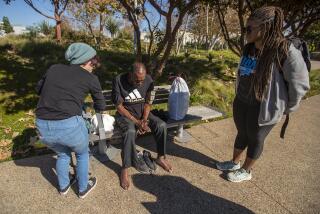Cases Dismissed in Santa Ana’s Homeless Sweep
- Share via
SANTA ANA — In a ruling that accused Santa Ana police of discriminating against the homeless, a judge Wednesday threw out charges against 22 people arrested in last summer’s Civic Center sweeps, some for plucking leaves from a tree or riding bicycles on a sidewalk.
After listening to three weeks of at times poignant and unsettling testimony, Municipal Judge B. Tam Nomoto found that officers had specifically sought out homeless people when they launched an unprecedented crackdown dubbed Operation Civic Center.
The judge noted that only homeless suspects had been arrested at the sprawling government complex and that police acknowledged releasing two of those arrested only because they could prove that they lived in residences.
And while the homeless suspects were arrested on extremely minor violations, she said, some officers admitted declining to arrest well-dressed people who had been seen committing similar violations.
Nomoto said expert defense testimony from a retired Los Angeles deputy police chief convinced her that “the arrest for innocuous violations and subsequent treatment of defendants was designed to harass and intimidate the homeless.”
“In short, this court finds that (the Santa Ana Police Department) deliberately and intentionally implemented a program which targeted those persons living in the Civic Center, the homeless.”
Homeless advocates said the ruling sends a powerful message to cities that try to use police to solve a complex social problem.
“This is a validation of what we believed all along,” said Justin Clouser of the Poverty Law Center in Santa Ana. “It is an inappropriate solution to a very serious problem. With this decision, we hope that the city of Santa Ana will be willing to sit down with us and talk about a better solution.”
Police Chief Paul M. Walters insisted, meanwhile, that his department had not targeted the homeless.
“The department does not engage and does not condone any activity that targets any particular group of individuals,” Walters said in an interview. “I’ve consistently said and demonstrated that our focus is on the violators of the law.”
Nomoto’s ruling was only the latest setback in Santa Ana’s efforts to control the homeless who gather on the Civic Center grounds.
Last year, the city settled a class-action civil suit that sprang from the same police sweeps, promising not to single out the homeless in law enforcement actions. In a separate matter, the City Council agreed to pay $50,000 to 14 homeless people who sued the city in 1988 after park workers seized and discarded their bedrolls and other personal property.
As part of that settlement, city officials agreed not to conduct large-scale maintenance sweeps through public areas. Instead, city workers are ordered to allow homeless people they encounter to collect their possessions and move on.
About 15 of the homeless defendants were present Wednesday when Nomoto delivered her ruling. Some of them openly wept. A few, carrying their belongings in tattered bags or knapsacks, hugged their attorneys and even shook the hand of the prosecutor.
“I feel elation and jubilation,” said Sharen Valentine, who had been arrested on a littering charge after dropping a cigarette butt. “I hope this makes sure that something like this will never happen again. We’ve been so lucky to have these attorneys look after us.”
Defense co-counsel Edmond M. Connor applauded Nomoto’s decision and described her as “courageous.”
“The judge is not afraid of political implications that might arise because of her ruling,” Connor said. “She called it as she saw it.”
During a Civic Center sweep Aug. 15, police rounded up more than 60 homeless people and transported them to nearby Santa Ana Stadium. There, identifying numbers were written in ink on their arms, and they were shackled to benches for several hours before being cited and release on offenses ranging from littering to jaywalking.
The roundup came at a time when the city had received complaints about crime at the Civic Center and when concern was growing among Santa Ana residents about the homeless problem.
Deputy Dist. Atty. Douglas D. Brannan argued that police had been justified in arresting people for minor offenses and had simply applied “the broken window theory,” which implies that major crime will occur if minor offenses are ignored.
But Nomoto dismissed the prosecutor’s argument: “If the Civic Center is to be compared to a house and the broken windows to minor offenses, all broken windows must be repaired. In this house, it is apparent that only those consisting of plain pane glass were handled, while those of bevel or stain glass were not.”
On Wednesday, Police Chief Walters complained that the county district attorney’s office was given insufficient time to prepare the prosecution, which landed in the county’s lap when Nomoto declared that the Santa Ana city attorney’s office had a conflict because it also represents the Police Department.
“I think it is unfortunate that the defense attorneys were significantly better prepared than the district attorney’s office,” Walters said. “The district attorney had one week to prepare, while the defense had four to five months.”
Assistant Dist. Atty. Maurice L. Evans declined to comment Wednesday.
In her ruling, Nomoto recalled testimony from one officer who recounted how he had seen a suspect tearing leaves from a county-owned bush. The officer alerted an arrest team, and the suspect was apprehended on suspicion of vegetation destruction.
Another officer testified that he had arrested a suspect for discarding a paper airplane and another for dropping a matchstick.
“It is indeed inconceivable that a person whose only offense was dropping a match, a leaf, pieces of paper or jaywalking would be subject to such treatment on a normal, standard basis,” Nomoto said.
“Yet police officers who have rarely if at all ever cited for jaywalking or littering testified that this was done.”
More to Read
Sign up for Essential California
The most important California stories and recommendations in your inbox every morning.
You may occasionally receive promotional content from the Los Angeles Times.













